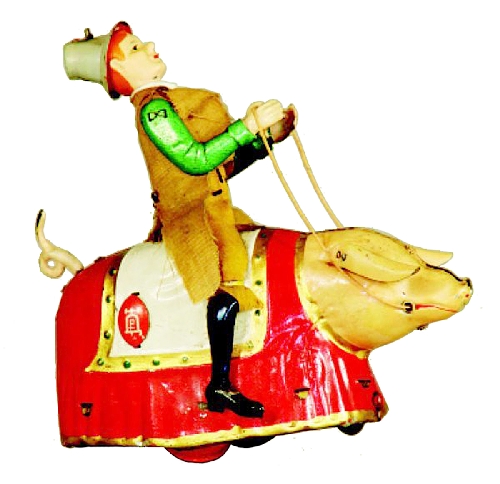Children’s love of circus duplicated by toys

Children love the circus, so what better toy than a model circus parade. In the late 19th century, cages of animals were drawn by horses through the main part of town to announce that the circus had arrived and to stage some shows. People along the parade route saw horse-drawn cages, elephants marching in a row, aerialists, clowns and other acts. Circus parades also featured music, spangled costumes and extravagantly decorated cages and wagons. The parade was a major event in town and became a preshow tradition.
By the 20th century, circuses had to compete with radio, then television, and new ways to advertise were used. But in the early 1960s, the circus parade returned and can still be seen in some cities. So, 21st-century children understand the circus toys of the past.
Toy replicas of circus wagons, animals and performers were made by many toy companies, including Schoenhut, Kenton Hardware, Arcade, Kingsbury and Hubley. The Hubley circus, made from 1906 to 1919, even had an iron “Royal Circus” calliope wagon that carried a music-making machine. It came in several sizes. In October 2010, a 16-inch-long calliope with horses, in mint condition with the box, was offered for sale. The original price in 1915 was $5.98. It auctioned for $19,000.
Q: I bought a Goebel Beatles figurine from a friend several years ago and am looking for something to compare it to. It is marked “Bull 307” and has a three-line Goebel mark. Others I have seen are painted; this one is all white. Can you help with any information?
A: A set of Beatles figurines inspired by the movie “Yellow Submarine” was issued in 1968 by the Goebel Porcelain Co. of Germany, famous for its Hummel figurines. It is thought that Goebel had some trouble with the colors its artists were using and stopped production after about 100 sets were made. Some of the sets were given away and the rest were never released for sale, making them the rarest of all Beatles memorabilia.
A few sets have sold at auction for between $15,000 (in 2000) and $18,000 (in 2002). Single figurines of Ringo Starr and George Harrison have sold for $800 to $2,700. Goebel reissued the Beatles figurines in a limited edition of 1,968 sets to celebrate the 40th anniversary of the release of the movie. They are identical to the originals and come in a display box with stand. They sell for about $1,000 a set.
Q: I have some ceramic molds that look like my modern tin Jell-O molds. When did they start making Jell-O?
A: Your early ceramic molds were used for gelatin desserts or salads. Beginning in the 14th century, molds were served at elaborate parties. Most popular were those with chopped cooked meat, cream, spices and sugar.
The gelatin, a form of animal collagen, was made by boiling animal skin, bones, even cattle hooves and other animal tissues. It was a time-consuming project. Then either sweet foods like fruit were added to make a dessert, or meat, poultry or fish were cooked and added to make a salad or first course. In 1845 the process became easier because a gelatin was made to be sold in stores. Charles Knox developed granulated gelatin in 1894, and in 1897 Jell-O was created.
Victorians thought elaborate molds should be served at every dinner party. Molds made of metal, particularly copper, were used. Molded foods went out of style in the first half of the 20th century, but in the 1950s molds came back. Layers of colored Jell-O or salads made with lime or lemon Jell-O and shredded cabbage were perfect for buffet dinners, the newest way to entertain.
Old and new molds are still easy to find and use.
Terry Kovel’s column is syndicated by King Features. Write to: Kovels, (Las Vegas Review-Journal), King Features Syndicate, 300 W. 57th St., New York, NY 10019.